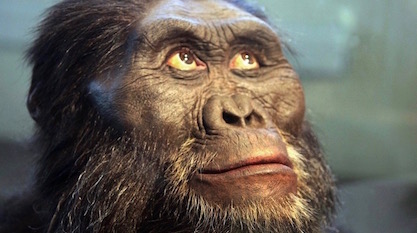 Evolution
Evolution
 Human Origins
Human Origins
Human Origins: Out of Africa, or Out of Germany?


In a recent article at Evolution News (Bechly 2017) I discussed seven major discoveries in paleoanthropology that have made 2017 a kind of annus horribilis for the established scientific consensus on human evolution. The most recent of these discoveries, fossil human footprints from Crete (Gierliński et al. 2017), was not only out of place in its Mediterranean location. In addition, it is 2.5 million years older than Lucy and the Australopithecus afarensis footprints from Eastern Africa.
Earlier this year Fuss et al. (2017) published an article that proposed hominin affinities of Graecopithecus from the Late Miocene (circa 7.2 million years ago) of Greece. I ended my article with the remark that “2017 is still not over. Maybe further surprises are ahead.” Indeed, it did not take long.
At a press conference on October 17, German paleontologist Herbert Lutz from the Mainz State Museum, who happens to be an old friend of mine, announced a sensational discovery (Hoppe 2017). In September 2016 two teeth were uncovered from sediments of the Proto-Rhine River near Eppelsheim in Rhenish Hesse, Germany. These layers of the Eppelsheim Formation were earlier known as Dinotheriensande, after the giant extinct Deinotherium elephants, and can be biostratigraphically dated near the end of Mammal Neogene biozone MN9 in the Middle Miocene, about 11.1-9.7 million years ago.
The two teeth, an upper left canine and an upper right first molar, clearly belong to an unknown hominoid ape. They have very distinct features that are characteristic of early East African hominin “ape-men” like Ardipithecus ramidus and Australopithecus afarensis. Boom! This raises the notion of an “out-of-place fossil” to a whole new level. Now the cradle of mankind has not only moved from East Africa to Southern Europe but even to Germany, and the age is about three times (!) the age of Lucy, indeed 3-4 million years older than the oldest known putative hominins from Africa (Sahelanthropus and Orrorin).
As usual in such cases, the popular science media proclaim another necessary rewriting of the human origins story. For example, IFL Science declares, “Extremely Unexpected Find Means We May Have to Rewrite the Human Evolution Textbook Again” (Anonymous 2017). DW Akademie echoes this: “Archaeology fossil teeth discovery in Germany could re-write human history” (Walsh 2017), while the mayor of Mainz, Michael Ebeling, remarked at the press conference, “I don’t want to over-dramatize it, but I would hypothesize that we shall have to start rewriting the history of mankind after today.”
To be clear, however, this is not just another find that merely tweaks our understanding of human origins. It represents nothing less than the final nail in the coffin of the still ruling “Out of Africa” paradigm. This year we could witness the collapse of the scientific consensus in paleoanthropology. In defeating Zombie Science (Wells 2017), it’s one down, and far from the first, but more to go.
Literature:
- Anonymous 2017. “Extremely Unexpected Find Means We May Have to Rewrite the Human Evolution Textbook Again.” IFL Science.
- Bechly G 2017. “Fossil Footprints from Crete Deepen Controversy on Human Origins.” Evolution News.
- Fuss J, Spassov N, Begun DR, Böhme M 2017. “Potential hominin affinities of Graecopithecus from the Late Miocene of Europe.” PLOS ONE.
- Gierliński GD et al. 2017. “Possible hominin footprints from the late Miocene (c. 5.7 Ma) of Crete?” Proceedings of the Geologist’s Association.
- Hoppe S 2017. “Archäologische Sensation in Rheinhessen — Wie ein Alien nach Eppelsheim gekommen.” SWR Aktuell.
- Lutz H, Engel T, Lischewsky B, von Berg A 2017. “A new great ape with startling resemblances to African members of the hominin tribe, excavated from the Mid-Vallesian Dinotheriensande of Eppelsheim.” First report (Hominoidea, Miocene, MN 9, Proto-Rhine River, Germany). Mainzer naturwiss. Archiv 54: preprint.
- Walsh A 2017. “Archaeology fossil teeth discovery in Germany could re-write human history.” DW Akademie.
- Wells J 2017. Zombie Science. More Icons of Evolution. Discovery Institute Press, Seattle, 238 pp.
Photo: Australopithecus afarensis, model, Smithsonian Museum of Natural History, by Tim Evanson, via Flickr.
